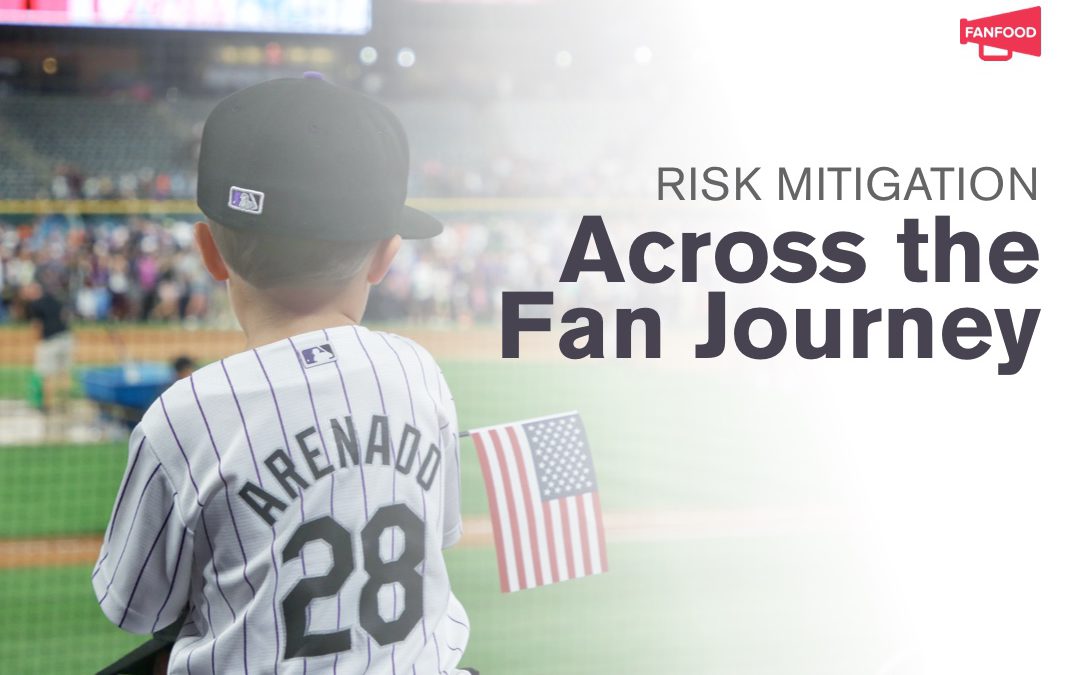As we help venues re-open this year with contactless ordering technologies, we understand that mobile ordering is only one piece of the overall re-opening plan puzzle.
 2. Manage ingress lines to mitigate COVID-19 transmission
Lines at the entrance and during ticket checking could prolong interactions with other attendees and increase risk of exposure. It’s therefore advised that upon ticket sale, assign staggered arrival times for all fans to avoid lines. The information can be printed on the digital ticket, or sent via a follow-up email, to inform fans of their expected arrival time and consideration of provision of parking spaces.
If needed, utilize CCTV and stewarding operation to manage breaches of social distancing at entry points.
3. Health surveys and temperature taking
To make sure that everyone admitted into the venue is of good health conditions and understand COVID-19 protocols, require all attendees to fill out a COVID-19 attestation form and/or a health survey to indicate that they are not displaying any symptoms, and that they understand the expected behaviors to comply with social distancing. You can also implement temperature taking procedures upon admitting the attendees with an infrared forehead thermometer.
2. Manage ingress lines to mitigate COVID-19 transmission
Lines at the entrance and during ticket checking could prolong interactions with other attendees and increase risk of exposure. It’s therefore advised that upon ticket sale, assign staggered arrival times for all fans to avoid lines. The information can be printed on the digital ticket, or sent via a follow-up email, to inform fans of their expected arrival time and consideration of provision of parking spaces.
If needed, utilize CCTV and stewarding operation to manage breaches of social distancing at entry points.
3. Health surveys and temperature taking
To make sure that everyone admitted into the venue is of good health conditions and understand COVID-19 protocols, require all attendees to fill out a COVID-19 attestation form and/or a health survey to indicate that they are not displaying any symptoms, and that they understand the expected behaviors to comply with social distancing. You can also implement temperature taking procedures upon admitting the attendees with an infrared forehead thermometer.
 To learn more about the 3 different ways for your venue to go cashless, visit our blog here.
To learn more about the 3 different ways for your venue to go cashless, visit our blog here.
Pre-Event
1. Create marketing campaigns for pre-event build up It’s important to educate your event attendees policy changes and safe behaviors leading up to the event. Non-compliant fan behaviors can lead to higher COVID-19 transmission risk, which as a results leads to a poor perception of the event and venue. Communicate clearly what is expected of the fans once they’re at the venue, and reassure them what are some policies or new amenities you’re offering this year to facilitate the their return. Make sure you’re distributing such information across multiple channels and repeatedly, so that more people can see it and take it to heart. Ideally, run a fan engagement campaign before re-opening that’s integrated with ticketing services, social media, website, press release, mobile apps, email marketing, signage, local radio/TV stations and more. Below is an example of the Yakima Valley Pippins’s announcement of using mobile concession ordering this season. Our team also works hands-on with the partners to plan marketing strategies, and provide content support when needed. 2. Manage ingress lines to mitigate COVID-19 transmission
Lines at the entrance and during ticket checking could prolong interactions with other attendees and increase risk of exposure. It’s therefore advised that upon ticket sale, assign staggered arrival times for all fans to avoid lines. The information can be printed on the digital ticket, or sent via a follow-up email, to inform fans of their expected arrival time and consideration of provision of parking spaces.
If needed, utilize CCTV and stewarding operation to manage breaches of social distancing at entry points.
3. Health surveys and temperature taking
To make sure that everyone admitted into the venue is of good health conditions and understand COVID-19 protocols, require all attendees to fill out a COVID-19 attestation form and/or a health survey to indicate that they are not displaying any symptoms, and that they understand the expected behaviors to comply with social distancing. You can also implement temperature taking procedures upon admitting the attendees with an infrared forehead thermometer.
2. Manage ingress lines to mitigate COVID-19 transmission
Lines at the entrance and during ticket checking could prolong interactions with other attendees and increase risk of exposure. It’s therefore advised that upon ticket sale, assign staggered arrival times for all fans to avoid lines. The information can be printed on the digital ticket, or sent via a follow-up email, to inform fans of their expected arrival time and consideration of provision of parking spaces.
If needed, utilize CCTV and stewarding operation to manage breaches of social distancing at entry points.
3. Health surveys and temperature taking
To make sure that everyone admitted into the venue is of good health conditions and understand COVID-19 protocols, require all attendees to fill out a COVID-19 attestation form and/or a health survey to indicate that they are not displaying any symptoms, and that they understand the expected behaviors to comply with social distancing. You can also implement temperature taking procedures upon admitting the attendees with an infrared forehead thermometer.
During the Event
1. Make use of in-venue marketing campaigns By now it should be standard practice that venues put up signage, video boards, and PA announcements to broadcast public health messages and updates to all attendees. For examples of what those assets could look like, please refer to our on-site marketing asset catalogue. Do take note that while people are inside the venue, you should still continue distributing the information via digital means, such as in the app, on social media and through text alerts. 80% of fans attending live events would still be checking their phones regularly, therefore digital marketing could achieve great results even for in-person marketing. 2. Minimize chances for people to congregate Waiting in lines, cash exchanges, waiting for food etc. can all lead to congregation at an event and as a result, prolonged interaction and exposure to COVID-19 risks. As much as possible, we encourage venues to enable “click and pick up” or “click and deliver” food ordering options to keep interaction to a minimum, and eliminate cash transactions. For example, FanFood’s mobile ordering platform allows people to scan a QR code and order from their seats. They can either come down to pick up their food at designated stands upon receiving a text alert, or have it delivered to their seats. This simple and flexible software doesn’t require hardware to start, since it’s all web-based, and doesn’t require fans to download an app (although they also have that option). It’s also designed for venues of all types and sizes, so that it can be configured to fit any budget level. To learn more about the 3 different ways for your venue to go cashless, visit our blog here.
To learn more about the 3 different ways for your venue to go cashless, visit our blog here.


Recent Comments